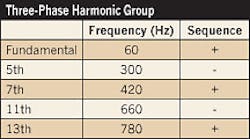Most modern industrial facilities have widespread applications of nonlinear loads, many of which represent a significant portion of the total facility load. As a result, they can inject harmonic currents into the power system, causing harmonic distortion in voltage.
Compounding this problem is the fact that these nonlinear loads typically have a low power factor (PF), forcing many industrial facilities to use capacitor banks to improve PF to avoid utility penalty charges. Ironically, this solution can cause some unforeseen problems. For example, the PF correction potentially can magnify harmonic currents, possibly presenting resonance conditions within the facility. These conditions, in turn, can cause motor and transformer overheating and problematic operation of susceptible electronic equipment. Let's take a closer look at some of the harmonics problems and solutions found in typical industrial environments.
Adjustable-speed drives and harmonics
A typical nonlinear load is the adjustable-speed drive (ASD).
Figure 1 (click here to see Fig. 1) shows a basic 3-phase, 6-pulse, pulse-width modulation (PWM) drive, which is the most common type. All PWM drives contain the following main parts, with subtle differences in hardware and software components. The input section of the drive is the converter, and it contains six diodes (arranged in an electrical bridge). These diodes convert AC power to DC power. The next section, the DC bus, sees a fixed DC voltage and filters/smooths out the waveform. The diodes actually reconstruct the negative halves of the waveform onto the positive half. In a 460V unit, you would measure an average DC bus voltage of about 650V to 680V. You can calculate this as line voltage times 1.414.
The DC bus feeds the final section of the drive: the inverter. As the name implies, this section inverts the DC voltage back to AC. However, it does so in a variable voltage and frequency output by using various types of power devices, such as silicon-controlled rectifiers (SCRs) or insulated gate bipolar transistors (IGBTs).
It's the converter part of the ASD that dominates the interaction of the drive with its source system. Therefore, how it functions determines the extent of the harmonics it will introduce into the electrical distribution system to which it's connected.
Production of harmonics by line-commutated converters is related to the pulse number of the device (see Drive Configurations and Harmonic Orders on page 22). The harmonic spectrum of a 6-pulse drive consists of the 5th harmonic (300 Hz) and 7th harmonic (420 Hz) as the lowest predominant orders.
PF improvement vs. harmonic resonance
Problems involving harmonics often show up at capacitor banks first because these units experience high-voltage distortion during resonance, and the current flowing in these banks can be significantly large/rich in a specific harmonic.
One way of looking at this is shown in Fig. 2. (click here to see Fig. 2) Here, we see a PF improvement curve superimposed over a harmonic resonance curve. Note that the 5th and 7th order harmonics are shown interfering across a wide area of capacitor addition, specifically in the high PF area in which you would normally want to have their performance characteristic. As you can see, the interference is significant.
If we were able to totally remove those harmonics, the resonance curve would not exist except at the far left of the graph, beginning with the 11th order. In other words, there would be no resonance interaction in the higher orders of PF.
For more detailed information, see the June 2003 EC&M issue article “Power Factor Correction and Harmonic Resonance: A Volatile Mix,” which can be accessed at www.ecmweb.com.
Harmonic impact on motors
According to the book “Electrical Power Systems Quality,” by Dugan, McGranaghan, Santoso, and Beaty (ISBN 0-07-138622-X), harmonics can significantly impact motors, basically through voltage distortion. This distortion at the motor's terminals translates into harmonic fluxes within the motor. These fluxes don't contribute much to motor torque, but they do rotate at a frequency different than the rotor synchronous frequency. This, in turn, induces high-frequency currents in the rotor.
The effect on motors is similar to that of negative-sequence currents at fundamental frequency: The additional fluxes do little more than induce additional losses. One indicator of harmonic voltage distortion is increased motor heating. Excessive motor heating problems usually begin when the voltage distortion reaches 8% to 10% and higher.
Another effect, according to the book “Power Quality,” by C. Sankaran (ISBN 9780849310409), is torsional oscillation due to the presence of harmonics. The 5th harmonic is a negative sequence harmonic, and the resulting magnetic field revolves in a direction opposite to that of the fundamental field at a speed five times that of the fundamental field. The 7th harmonic is a positive sequence harmonic, with a resulting magnetic field revolving in the same direction as the fundamental field at a speed of seven times the fundamental. The net effect is a magnetic field revolving at a speed of six times the speed of the rotor.
The resulting interaction between the magnetic fields and the rotor-induced currents produces torsional oscillations of the motor. If the frequency of the oscillation is the same as the natural frequency of the motor rotating members, severe damage to the motor can occur. Other indicators include decreased efficiency and high-pitched noises.
Some ASD harmonic solutions
The most effective means of avoiding high oscillating current between capacitors and harmonic-producing equipment is the installation of filters tuned to absorb specific offending harmonics.
Tuned passive filters
When installed close to the line-side terminals of the equipment, filters provide the lowest impedance path for the harmonics currents to flow. As a result, these currents will not be introduced into the rest of the distribution system, where they can cause wave distortion and damage or tripping of PF correction capacitors. (click here to see Fig. 3) shows this concept.
Phase manipulation
Let's consider the example of a 100kW 6-pulse converter. The electrical angle between firings is 60° (360° ÷ 6). Now consider this: What if instead of a single unit, it consisted of two parallel 50kW 6-pulse units? If the firing position of each of the supplies is adjusted so that one fires every 30° rather than 60°, an equivalent of a 12-pulse unit has been created “electrically.” The 5th and 7th harmonics are eliminated.
You can also achieve this by using dual-wound transformers, where the primary is delta and the secondary is wound with two output windings: a wye and a delta. The result is on transformation being 30° apart, creating the equivalent of a 12-pulse unit. You can achieve the same result by using two transformers, one wired delta-delta, and the other delta-wye. Figure 4 (click here to see Fig. 4) shows this application.
Harmonic currents cause voltage distortion, with the highest distortion levels occurring close to the harmonic source. Therefore, you must evaluate the various available harmonic control schemes by controlling harmonic injection from nonlinear loads or blocking the flow of harmonic currents by applying harmonic filters.
Sidebar: Drive Configurations and Harmonic Orders
The Table is a listing of 3-phase harmonic currents and their respective frequencies and sequence. These harmonics are normally associated with phase-to-phase nonlinear loads and have frequencies that are integer multiples of the 60Hz fundamental.
Note that the listed harmonic orders are one number below and one above “6” and “12,” respectively. In effect, the relationship of pulse number to harmonic order is expressed by the following equation: h = kq ± 1
Where “h” is the harmonic order, “k” is any integer, and “q” is the pulse number of the device/circuit.
For a 6-pulse drive then, insert the number “6” for “q” and the integer “1” for “k.” Solving for “h,” we find that a 6-pulse device will generate the 5th and 7th order harmonics. By inserting the integer “2” for “k,” we find that the 11th and 13th harmonics also will be present. Thus, the Table can be extended to include other normally present 3-phase harmonics with 6-pulse devices, such as the 17th and 19th, 23rd, and 25th, etc.
You can also use the equation above to determine the harmonic orders for 12-pulse devices by inserting the number “12” for “q”. The equation then yields the 11th and 13th harmonics for the integer “1,” 23rd, and 25th for integer “2,” etc.



